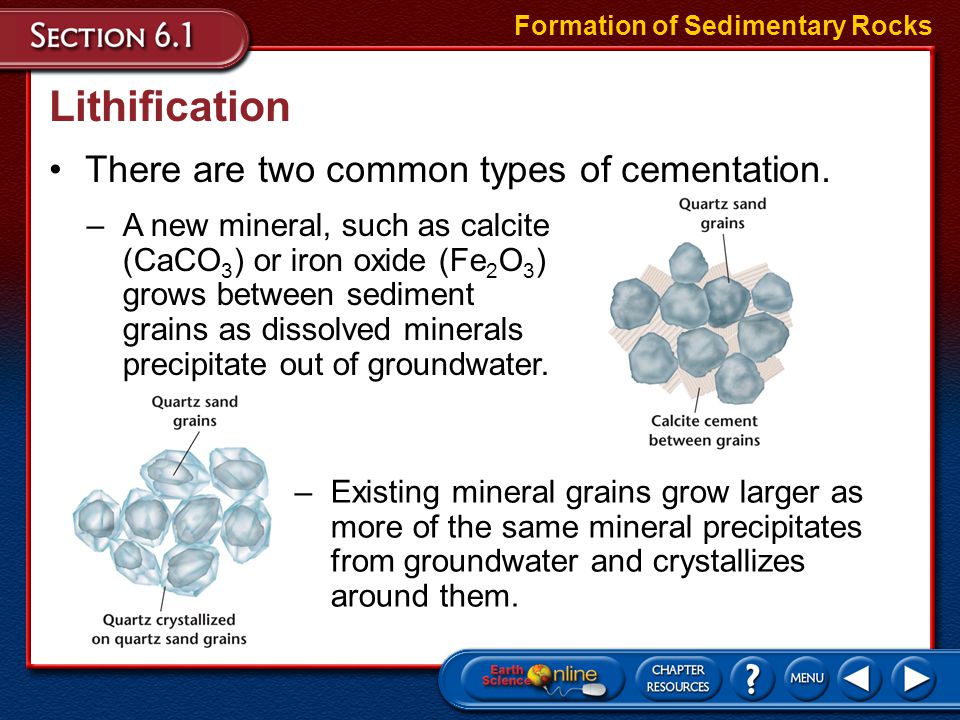Describe the Two Main Types of Cementation
Compaction involves squeezing the sediment into a smaller volume by packing the sediment particles more closely by removing water from the pore space desiccation or by pressure solution at the points where sediment grains contact each other. Portland cement contrary to popular belief is not a brand of cement but the most common type which is used as an ingredient in concrete and mortar all around the world.

Geological Society Compaction And Cementation
The main processes involved in lithification are compaction and cementation.

. High alumina cement 7. Aqueous solution of sodium silicate. This is another concrete that uses the common mix design of 124 with its components of.
Blast furnace slag cement 8. The cement which can be setbind in wet condition or with water and further protects the hardened. Rapid hardening cement 3.
Following are the two types of metamorphic rock. Lime is calcium oxide or calcium hydroxide. Marble quartzite are examples of non.
Types of Cement Acid-resistant cement. There are several different types of cements of which Portland cement Siliceous ASTM C618 Class F Fly Ash Calcareous ASTM C618 Class C Fly Ash slag cement and silica fume are the major types 9 10. Oolitic an inorganic limestone formed by precipitation calcite from fresh water in a stream or lake.
Cement can be divided into two categories. Small pieces of fragmented rocks deposited as a result of mechanical weathering then lithified by compaction and cementation. Plain or Ordinary Concrete.
It is the most. Cement on reacting with water commences the hydration reaction. These cements are designed to meet the varying needs of the construction industry.
The Types of Concrete 1. These rocks dont have layers. The main features of these cement ingredients along with their functions and usefulness or harmfulness are given below.
C150 provides for eight types of Portland cement. The cement which is not set underwater or wet condition is called Non-Hydraulic Cement. The cement forms an integral and important part of the rock and its precipitation affects the porosity and permeability of the rock.
Acid-resistance aggregates such as quartz quartzites etc. The slag is a waste product. These include clastic chemical and organic sedimentary rocks.
Properties of Extra Rapid hardening cement. This concrete combines all the basic ingredients concrete sand and aggregate using the. For this cement type the slag as obtained from blast furnace is used.
In addition some blended cements have special performance properties verified by additional testing. Two types of cements A and B have fineness of 350 m2kg and 550 m2kg respectively. The ASTM Spec.
Explain which type of cement will be more suitable for concreting in cold weather. They differ from their chemical composition. It is the last stage in the formation of a sedimentary rock.
At the age of one or two days strength of Extra rapid hardening cement is 25 more than rapid hardening cement and only 0-20 higher at 7 days but at 90 days both cement have nearly the same strength. Phyllite gneiss are examples of foliated metamorphic rocks. Clastic sedimentary rocks are formed from the buildup of clatics.
Quick setting cement 6. Hydraulic cement is a type of cement that not only harden on reacting with water but also form water-resisting products. Cements occur in all types of siliciclastic carbonate and evaporite strata and include an enormous variety of minerals.
The use of Extra rapid hardening cement in pre-stressed concrete is prohibited. Air entraining concrete admixture. Types of Metamorphic Rock.
Sedimentary rocks are of three basic types. Up to 10 cash back Precipitation of cements can occur at any stage from deposition through burial to uplift and re-exposure. Cement Type Description Type IL Portland-Limestone Cement Type IS Portland-Slag Cement Type IP Portland-Pozzonlan Cement Type IT Ternary Blended Cement.
Cementation in geology hardening and welding of clastic sediments those formed from preexisting rock fragments by the precipitation of mineral matter in the pore spaces. Some of the most common cement classifications are. Types of Sedimentary Rocks.
The most common cements are carbonates especially calcite aragonite dolomite and siderite silicates. These rocks are produced by the exposure to heat and pressure which makes them appear layered. An inorganic limestone formed by cementation of spheres of calcite in warm shallow sea water describe the type of limestone.
Deficiency in lime reduces the strength of property to the cement. Low heat cement 5. Types of Cement Hydraulic Cement.
Types of Concrete Admixtures Concrete admixtures are of different types and they are as follows. Types I IA II IIA III IIIA IV and V where the A denotes an air-entraining cement. 13 rows Types of cement 1.
Describe the potential differences in term of water requirement heat development and rate of strength development for both types of cements. Type I and II are the most common types of Portland cement in the US. The presence of lime in a sufficient quantity is required to form silicates and aluminates of calcium.
Alkali Aggregate Expansion Inhibiting Admixtures. Together they account for more than 92 of the total cement production.

Objectives Vocabulary Sequence The Formation Of Sedimentary Rocks Ppt Download

Cementation An Overview Sciencedirect Topics
Creating Sandstone And Other Sedimentary Rocks Requires Three Steps 1 Deposition 2 Compaction 3 Cementation The Third Geology Sedimentary Rocks Sedimentary
Comments
Post a Comment